
«Manger» is one of the brightest star clusters in the earth's sky. It is inferior in brightness to the Pleiades and Hyades, but is one of the seven mysterious (obscure in appearance) celestial objects of the Almagest star catalog of Claudius Ptolemy, which means it has been known to people since ancient times.

Claudius Ptolemy
And what else was there — in this catalog? The Andromeda Nebula, the Orion Nebula, χ-h Perseus (also an open cluster, moreover, a double one), the "Sandal Sole" in Gemini, a stellar association in Coma Berenices constellation (Melotte 111) and the "Ptolemy Cluster", located in the tail of Scorpio, now known as M7 — this is company of the open stellar cluster «Manger» (from Cancer constellation) in ancient times. It can be clarified that it got into the Almagest from the catalog of Hipparchus, who lived 300 years before Ptolemy — in the second century BC. But Hipparchus was not the discoverer of «Manger» — this cluster was mentioned in the writings of Eudoxus of Cnidus (5th century BC). On this, scientific research is lost in the depths of ancient times, but mythological ones remain, which are much more ancient.

Hipparchus
According to Greek mythology — «Manger» — a feeder of the donkeys on which the god of winemaking Dionysus and his faithful companion Silenus went to battle with the Titans. The heart-rending roar of the approaching donkeys distracted the Titans, they lost their vigilance and were defeated by Zeus-Thunderer, who took advantage of the momentary confusion of the enemies. But all the glory went to the donkeys, who, after the end of the Titanomachy, were taken to heaven, turning into the stars Gamma and Delta of Cancer constellation. And so that the donkeys would not starve, the Gods placed a feeding trough right between them — «Manger» — a pale smoky spot, visible only on a moonless night.
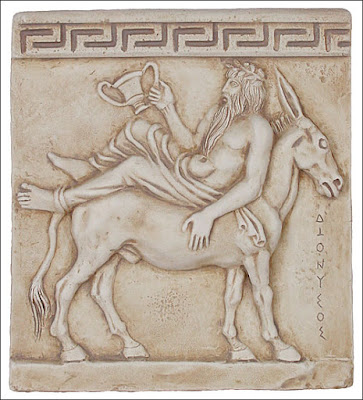
Dionysus rides on a donkey to fight the Titans
And it doesn't matter that Dionysus is the last of the Olympian gods to come into being, when the Titans were fall long ago — Greek mythology does not need to be strictly coordinated with linear time. After all, Cancer constellation also appeared in the sky only after Hercules defeated the Nemean Lion ... and this is almost our time — the time of people.

In the view of Chinese and Japanese astronomers of the ancient era, this dim smoky spot among the stars personified the entrance to the afterlife of the departed souls, and caused a feeling of fear.
In "Uranometria" star atlas by Johann Bayer, the «Manger» star cluster was marked with the Greek letter ε (epsilon). By the way, it was Bayer who came up with the designation of stars in Greek letters. But in this case, he applied the introduced rule to foggy objects (although, for example, this did not affect the Andromeda Nebula).
Note: There is another name for this stellar cluster — "Beehive".
A few years after the publication of Uranometria, Galileo Galilei pointed a telescope at «Manger» and separated it into individual stars, counted something about 40 individual stars. Since then, the Greek letter ε refers only to the cluster's brightest star, and the cluster itself received number 44 in the catalog of Charles Messier, a famous comet catcher, who made his catalog with a specific practical meaning — to conduct an all-celestial census of objects that look like comets, but are not comets . In the first edition of the catalog, Charles Messier listed 43 objects, and the Major and Minor Orion Nebulae were listed last. But Charles had a competitor — Nicolas-Louis de Lacaille, who worked on a similar catalog, and in terms of the number of objects "stepped on the heels" of Messier. To overtake his colleague, Charles included two more objects in his catalog just before the press. So in Messier's catalog were «Manger» (number 44) and the Pleiades (number 45). Although, neither one nor the other, when observed through a telescope, has any resemblance to comets.

Charles Messier
Now every amateur astronomer can easily divide «Manger» into individual stars — binoculars or a spyglass are enough for this, and observation of the cluster through a telescope is preferable only at the lowest magnifications so that it can fit in the field of view, because the cluster is very large — 1.5 degrees.
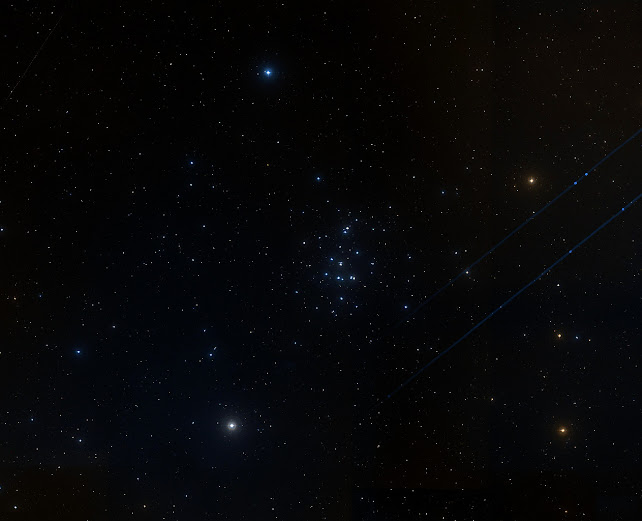
Open stellar cluster M44 «Manger»
By the way, people with exceptional visual acuity can divide the Nursery into separate stars without optics. For some reason, this did not happened in the pre-telescopic era. Have people become more vigilant, or does knowledge give the ability to see more?
It is believed that «Manger» is one of the open stellar clusters closest to the Sun. At the same time, both the Hyades and even the Pleiades are noticeably closer. The Manger cluster is about 600 light-years away — not to say that it is very close. But still, the vast majority of open clusters accessible to amateur telescopes are located much further. For example, the χ-h Perseus double cluster, perfectly visible to the eye, is 12 times farther than the «Manger» — 7500 light years. Compared to this distance, a distance of 600 light years no longer seems so infinite.
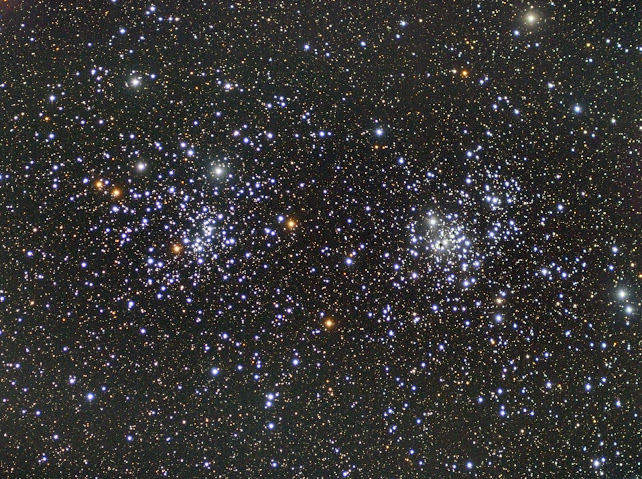
Double open stellar cluster χ-h Perseus
And it's all the more surprising that astronomers have recently revealed a connection between the Hyades (the open cluster closest to us) and «Manger».
Note: I have special articles on the Hyades and Pleiades clusters. I recommend reading them too — to get a complete picture.
The Hyades are 4 times closer to us than «Manger». Between these clusters there is a cosmic abyss of several hundred light-years. But this is now. And 600 million years ago, the stars of these clusters were born from the same gigantic protostellar nebula — similar to the one we now observe in Orion constellation. Of course, there is no trace of those clouds of gas and dust now. And the stars born in them rushed along their galactic trajectories — the Hyades were a little slower, and the «Manger» for some reason turned out to be faster, and for 600 million years (approximately the same age of both clusters) noticeably broke away from their brothers and sisters from another clusters. But the origin of the stars of «Manger» and Hyades clusters is joint.
Both clusters are also close in the composition of the stellar population — they are dominated by cool and already old stars of spectral types K and M with high metallicity. If astronomers managed to discover only one exoplanet in the Hyades, then six are already known in «Manger».
The sizes of the clusters and the number of stars in them are practically the same — about 1000 stars per sphere with a diameter of about 30 light years.
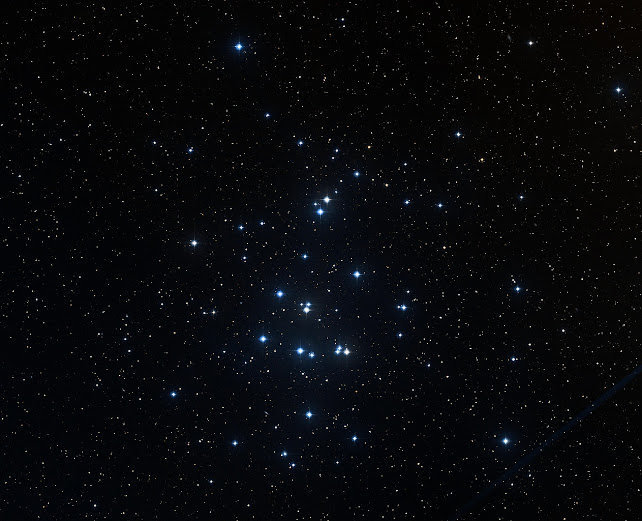
Open stellar cluster M44 «Manger»
At the same time, both clusters are now in a pre-decay state — a significant part of their stellar population has already dispersed into space, and in a few tens of millions of years the rest will also scatter — pretty soon (according to galactic time scales) both star clusters will cease to exist — as subgalactic stellar structures. But many of their constituent stars will roam the expanses of the Milky Way alone for a very long time, because for the most part these are dwarf stars whose life lasts billions of years.
Let me once again shift my gaze to the border of Perseus and Cassiopeia constellations, where a double open cluster is ghostly smoldering, marked on the map by the letters χ and h — how is it not similar to the clusters «Manger» and Hyades? χ-h Perseus — young clusters — they are only 13 million years old, they are located close to each other and fly in our direction. But the speed of their approach is different — 38 and 39 kilometers per second. This means that one cluster is moving through space at least 1 kilometer per second faster than the other. What will happen to them in 500 million years?
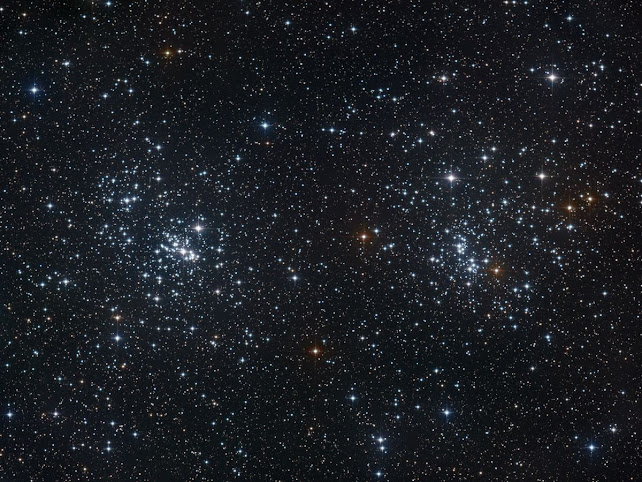
Double open stellar cluster χ-h Perseus
A simple calculation shows that by the time when the age of both the χ and h Perseus clusters reaches the age of the Hyades and «Manger», one cluster will overtake the other by one and a half thousand light years. This is quite correlated with the distance that the Hyades and «Manger» have gained — several hundred light years. This means that we have two typical examples of how stars are born in huge gas clouds, grouped into densely populated open clusters, and then these clusters scatter across the Galaxy, maintaining integrity for at least several hundred million years.

Cancer constellation, in the central part of which the open stellar cluster «Manger» is located, belongs to the group of spring constellations. But the best time for its observations in winter is in January and February. However, Cancer is clearly visible from mid-autumn to mid-spring.

There are no bright stars in this constellation, so the stars of neighboring constellations will help you look for the open cluster «Manger». If you connect the brightest stars of Leo and Gemini constellations — Regulus and Pollux with a straight line, then approximately in the middle of this segment (a little closer to Pollux) you can easily find a compact star scattering with binoculars. And if the sky is dark and transparent, then even with the eye you can see a foggy speck, a little larger than the Moon. In search of the cluster, "donkey stars" will also help you. They still bear their "donkey names" — "Azellus Borealis" (Northern Donkey) and "Azellus Australis" (Southern Donkey). Both stars are significantly closer than the Manger cluster — 3 and 4 times, respectively.



No comments:
Post a Comment